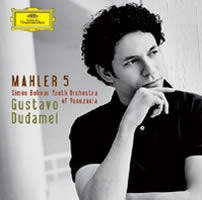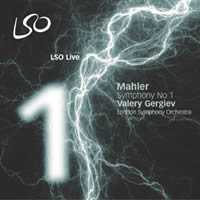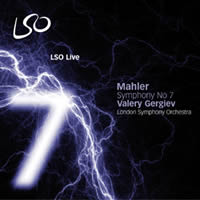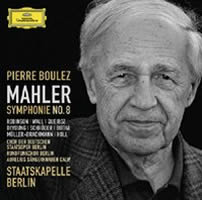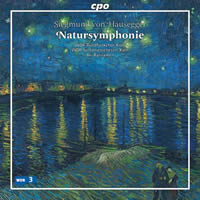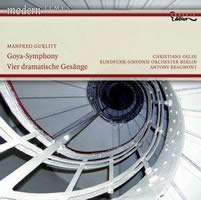Mostly Symphonies 8. (Austro-Germanic)
|
Grant Chu Covell [November 2008.]
Leopold MOZART: Sinfonia in G major (Eisen G8, ca. 1750/60); Berchtesgadener Musik, “Kindersinfonie” (“Toy Symphony”) (ca. 1750/60); Sinfonia in D major (Eisen D15, ca. 1750/60); Sinfonia in A major (Eisen A1, ca. pre-1750); Sinfonia in G major, “Neue Lambacher Sinfonie” (ca. 1767). Toronto Chamber Orchestra, Kevin Mallon (cond.). Naxos 8.560499 (http://www.naxos.com/). History has not treated Wolfgang’s father well. Adulation for the son comes at the expense of the elder teacher, composer, violinist and impresario. This Naxos disc’s bright revelations set Leopold’s music in context: five symphonies whose period and style overlap the sons of Papa Bach and early Haydn. Several have been misattributed to Wolfgang thanks largely to eager publishers looking to trade on junior’s name, and the Toy Symphony’s attribution may never be definitive. Naxos nicely captures the Toronto players who give fleet readings. The especially delightful opening G major Sinfonia’s Andante contains some wondrously feathery progressions.
Gustav MAHLER: Symphony No. 5 (1901/2). Simón Bolívar Youth Orchestra of Venezuela, Gustavo Dudamel (cond.). DG B0009837-02 (http://www.deutschegrammophon.com/). DG captures the young Venezuelans and their young conductor’s suitably aggressive achievement. The remarkable balance permits one to hear more clearly than usual bassoons and horns when they double strings, as well as individual voices in the Scherzo and Finale’s fugal sections. Tricky moments, such as the trumpet fanfares, are template perfect, and the strings have mastered Mahler’s characteristic fps and swelling dynamics. And yet I craved more recklessness, especially at tempo changes such as the first movement’s sudden lurch (“Plöztlich schneller. Leidenschaftlich. Wild.”), the second movement’s sunburst, and the ritardando just before the Finale’s coda. Unexpectedly, the Adagietto grows clinical as the strings’ pearly pianissimo snuffs out all warmth. The Scherzo is particularly fine, perhaps because its emotive neutrality requires great endurance. The Fiesta release (DG B0011340-02) confirms that these players deliver passion with volume: Revueltas’ Sensemaya and Bernstein’s Mambo (from West Side Story) are all elbows, the kinetic layers of Ginastera’s Danza final (Malambo from Estancia) chisel sharp. Nothing is whispered. A greater range of finesse appears in the troupe’s debut release of Beethoven’s Fifth and Seventh (DG B0006899-02), the latter a particularly fine rendition.
Gustav MAHLER: Symphony No. 1 (1884-88; rev. 1893-96). London Symphony Orchestra, Valery Gergiev (cond.). LSO LSO0663 (SACD) (http://lso.co.uk/). Distributed in the US by Harmonia Mundi (http://www.harmoniamundi.com/). Gustav MAHLER: Symphony No. 6 (1903-06). London Symphony Orchestra, Valery Gergiev (cond.). LSO LSO0661 (SACD) (http://lso.co.uk/). Distributed in the US by Harmonia Mundi (http://www.harmoniamundi.com/). Gustav MAHLER: Symphony No. 7 (1904-05). London Symphony Orchestra, Valery Gergiev (cond.). LSO LSO0665 (SACD) (http://lso.co.uk/). Distributed in the US by Harmonia Mundi (http://www.harmoniamundi.com/). For someone who has grown tired of cloying Mahler Firsts, this unsentimental performance is a blessing. Breaking tradition, Gergiev employs the full double-bass section at the opening of the funeral march and refuses to dawdle in the Finale. A cool “Titan” might have its merits, but not when the high points pass unremarkably. Not unexpectedly, Gergiev’s Sixth operates at a quick clip. The hurried first movement passes almost comically, as if the tragedy were simply a matter of getting to the dry cleaners in time. Consequently, the high-energy scherzo has nowhere to go. The caricature shifts gears in the last movement, which crests like a cinematic blockbuster. Gergiev’s manic urgency works to superb effect in the Seventh. Compared to the First and Sixth, everything clicks. The progression though the Nachtmusiks toward the Finale reveals a tidy logic. Gergiev teaches us that in his Seventh, Mahler was departing the sentimental Wunderhorn terrain for a more dissonant territory, case in point, the tenor horn’s ambiguous opening call. Indeed, this symphony contains the seeds Berg would soon sow. (Will Gergiev tackle the Op.6 Three Pieces?)
Gustav MAHLER: Symphony No. 8 (1906-07). Twyla Robinson, Erin Wall, Adriane Queiroz (sop), Michelle DeYoung, Simone Schröder (alt), Johan Botha (ten), Hanoo Müller-Brachmann (bar), Robert Holl (bass). Staatskapelle Berlin, Chor der Deutschen Staatsoper Berlin, Rundfunkchor Berlin, Aurelius Sängerknaben Calw, Pierre Boulez (cond.). DG 00289 477 6597 (2 CDs) (http://www.deutschegrammophon.com/). Sooner or later, Boulez would have had to tackle this one, having nailed down the others with Chicago (1 and 9), Cleveland (4 and 7) and Vienna (2, 3, 5 and 6). Certainly, DG would have been insane to start with the ebullient, operatic Eighth, yet the music actually suits Boulez’s fastidious ways. The first part’s thrilling counterpoint builds clearly. The second part’s jubilation remains buttoned-up and consequently disappoints. In the booklet, Mahler scholar Henri-Louis de la Grange notes that the Eighth is the first Mahler work “not to contain any quotations or distant and stylized echoes of any fanfare, march or Ländler.” It’s true that this grand choral symphony is like nothing else Mahler wrote, and yet in Boulez’s hands, I hear this interpretation echoing the Seventh’s second Nachtmusik in the Eighth’s first part.
Siegmund von HAUSEGGER: Natursymphonie (1911). WDR Sinfonieorchester Köln, WDR Rundfunkchor Köln, Ari Rasilainen (cond.). cpo 777 237-2 (SACD) (http://www.cpo.de/). Distributed in the US by Naxos (http://www.naxos.com/). Hausegger’s impressive symphony belongs in the collection of any Mahler or Strauss fan. However, despite Rasilainen’s advocacy, one doesn’t easily warm to the music’s restless profusion of ideas and twisting tonality. To a full orchestra Hausegger (1872-1948) adds organ and chorus, with Goethe’s text appearing only in the final moments. Hardly bucolic, this composer/conductor’s “nature” is dramatic, unpredictable, and — to judge from the second-movement funeral march — sinister.
Manfred GURLITT: Goya-Sinfonie (1938-39); Four Dramatic Songs (1950-52). Christiane Oelze (sop), Rundfunk-Sinfonieorchester Berlin, Antony Beaumont (cond.). Phoenix Edition 114 (http://www.phoenixedition.com/). Distributed in the US by Naxos (http://www.naxos.com/). The Nazis having successfully stifled his career, Gurlitt relocated to Japan in 1939, where he cultivated a conducting career, though his music, including the Goya Symphony which premiered in Tokyo in 1943, made little impression. A European trip in 1955 did nothing to restore his reputation — perhaps his difficult character and an ambivalent attitude towards the Third Reich caught up with him. His acknowledged masterpiece is an opera written 1921-25 that Berg’s identically named Wozzeck overshadowed. If you know Berg’s opera, it’s unsettling to hear Büchner’s words with different music (Capriccio 60052-1). Gurlitt also penned a Die Soldaten, anticipating but not preempting B.A. Zimmermann. Gurlitt’s expressive tonality, blending Strauss with Hindemith, is firmly anchored in the 19th century. Polytonality adds spice, as in the first movement’s folksy theme with horn-call fourths, though it never reaches Nielsen or Mahler’s adventurous development. From afar it would be possible to think one was listening to Prokofiev or Ives, absent the irony. Gurlitt insisted that the symphony is program music, the movements having been inspired by Goya’s paintings and life, while the encroaching bleakness may have been autobiographical. Recalling Schoenberg’s orchestral songs, Gurlitt’s four briskly guide the soprano through texts by Ernst Hardt, Goethe and Gerhart Hauptmann, with too few moments for Oelze to soar or the orchestra to sing.
HANS WERNER HENZE: Adagio, Fuge und Mänadentanz (Suite aus der Oper “Die Bassariden”) (2004); Nachstücke und Arien (1957); Symphony No. 8 (1992-93). Claudia Barainsky (sop), Gürzenich-Orchester Köln, Markus Stenz (cond.). Phoenix Edition 113 (http://www.phoenixedition.com/). Distributed in the US by Naxos (http://www.naxos.com/). Henze’s vocal and chamber works usually leave me cold, but I do admire his sizzling orchestration and powerful dramatic sense, especially the music’s strong currents. For one who thinks of his Seventh as a high point, this predominantly orchestral release offers comparable energy. Evidently Henze is at his best when working with a program, explicit or lurking. The Adagio, Fuge und Mänadentanz distills the opera Die Bassariden, culminating in the orgiastic catastrophe. Darmstadt ringleaders Boulez, Stockhausen and Nono famously walked out on the premiere of the lush Nachstücke und Arien back in the days when the only world that mattered had twelve sides. Who was right? The question’s no longer significant. Whirling through faeries, mistaken identity and a final frenzy, the Eighth takes its direction from A Midsummer Night’s Dream. I vaguely recall attending the Boston Symphony premiere, and think I heard it over the radio, but don’t remember this level of energy and variety.
[More Grant Chu Covell, Mostly Symphonies]
[Previous Article:
Armchair Operas 2.]
[Next Article:
Erster Spaziergang]
|

